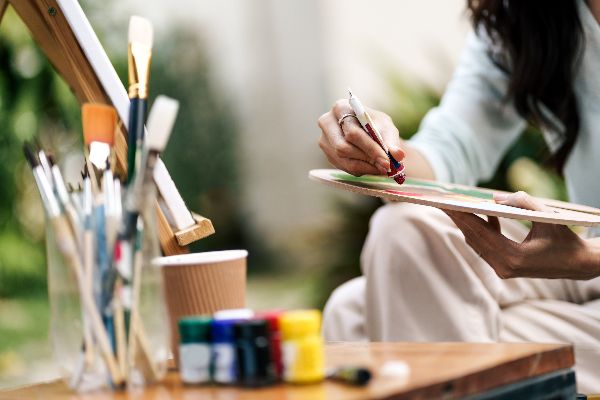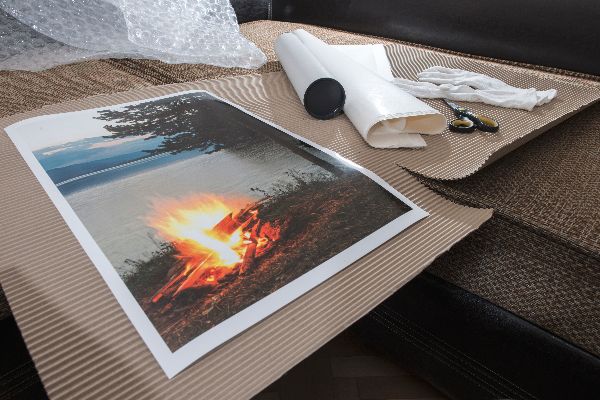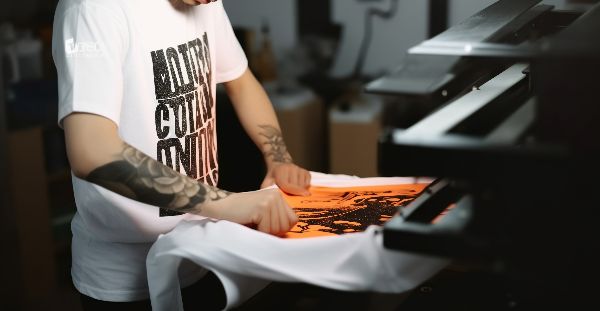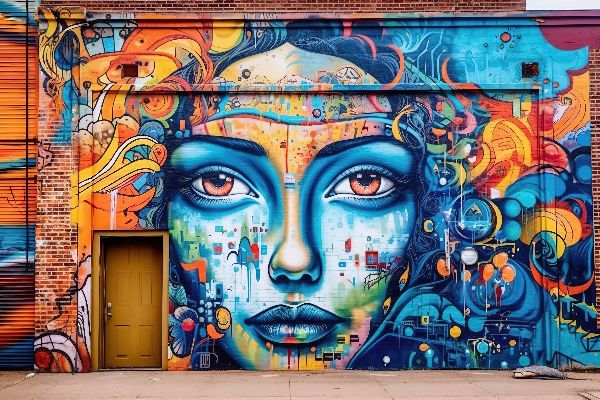Mind Body Education
Award-Winning Training For Holistic Therapists
Get your free eBook
Earning from Art
A step-by-step guide to making an income as an artist

10 Ways to Make an Income from Your Art
But you also want to eat, right?
You need to pay for accommodation and the other necessities (maybe even some luxuries) of life.
So how can you follow your passion, allow your creative spirit to guide you, and still generate a good income, maybe even a great income?
We have some answers for you!
Here are ten ways you can make a living while working full-time as an artist.
Making money from your art is crucial for you as an artist, to validate your talent and dedication but also to help you sustain a career in a highly competitive and often unpredictable creative industry.
Beyond the obvious need to make a living, financial success provides artists with the means to invest in quality materials, dedicate more time to their craft, and explore new artistic avenues without the burden of financial constraints. It allows them to attend workshops, acquire necessary equipment, and showcase their work through exhibitions or online platforms.
So how can you follow your passion, allow your creative spirit to guide you, and still generate a good income, maybe even a great income?
We have some answers for you!
Here are ten ways you can make a living while working full-time as an artist.
Making money from your art is crucial for you as an artist, to validate your talent and dedication but also to help you sustain a career in a highly competitive and often unpredictable creative industry.
Beyond the obvious need to make a living, financial success provides artists with the means to invest in quality materials, dedicate more time to their craft, and explore new artistic avenues without the burden of financial constraints. It allows them to attend workshops, acquire necessary equipment, and showcase their work through exhibitions or online platforms.

Artists make a powerful difference in the world.
Moreover, financial stability empowers artists to focus on honing their skills and creating meaningful, innovative pieces without the distraction of financial worries.
Earning from art serves as a recognition of the artist's contribution to culture and society, reinforcing the idea that art is not only a form of self-expression but also a valuable and marketable skill deserving of support and compensation. But did you know it is also a powerful and scientifically proven way to heal mental, emotional and even physical ailments?
Earning from art serves as a recognition of the artist's contribution to culture and society, reinforcing the idea that art is not only a form of self-expression but also a valuable and marketable skill deserving of support and compensation. But did you know it is also a powerful and scientifically proven way to heal mental, emotional and even physical ailments?
Here are 10 great ways to make an income from your art, and watch out for bonus number 11! It can help you create a career that provides you with financial stability and the freedom to work creatively for yourself while you make a powerful positive difference in the world by helping others live happier and healthier lives.
Freedom - Creativity - Passion - Financial Security
AND True life purpose


#1 - Sell Artwork
Selling artwork can take both traditional and digital forms, each presenting unique opportunities for artists to reach diverse audiences.
In the traditional realm, artists can showcase and sell their physical pieces through galleries, art shows, or by directly engaging with potential buyers. Galleries provide exposure within the art community, while art shows offer direct interactions with art enthusiasts. Establishing a personal connection with buyers can foster a deeper appreciation for the artist and their work.
On the digital front, artists can leverage online platforms such as Etsy, Redbubble, or Society6 to sell digital prints or licenses of their creations. These platforms provide a global marketplace, enabling artists to reach a vast audience and diversify their income streams. The digital approach also allows for greater flexibility, as artists can easily manage and promote their portfolios, expanding their reach beyond geographic limitations. Whether through traditional channels or digital platforms, selling artwork not only generates income but also establishes a broader presence for artists in the ever-evolving landscape of the art market.

#2 - Commissions
Accepting commissions is a dynamic avenue for artists to engage with their audience and create bespoke pieces tailored to individual preferences. Artists can open themselves up to commissioned work by advertising their availability on social media, personal websites, or through word of mouth. The process typically involves collaborating closely with clients to understand their vision, whether it's a portrait, illustration, or personalized artwork.
Clear communication about expectations, deadlines, and pricing is crucial to ensure a positive and professional experience for both parties. Through commissions, artists not only hone their adaptability and skill in translating diverse visions into tangible creations but also establish a direct and personal connection with clients, fostering a sense of satisfaction and ownership in the final product. This personalized approach not only allows artists to showcase their versatility but also serves as a unique and rewarding way to monetize their craft while forging meaningful connections with patrons.

#3 - Art Prints
Creating art prints is a strategic method for artists to make their work more accessible to a broader audience while adding value to their brand.
To embark on this venture, artists can partner with reputable print shops or invest in high-quality printing equipment to reproduce their artwork faithfully. Offering both limited and open editions caters to different market preferences; limited editions, often signed and numbered, create a sense of exclusivity and collectibility, adding perceived value for collectors.
Artists can sell these prints through various channels, such as online platforms, galleries, or at art events. Effective marketing, emphasizing the uniqueness of each print, can contribute to the success of this venture. Art prints not only provide artists with an additional revenue stream but also democratize access to their creations, allowing a wider audience to enjoy and collect their work.

#4 - Online Courses and Tutorials
Embarking on the creation of online courses and tutorials is a powerful way for artists to share their expertise and monetize their skills. By leveraging platforms like Udemy or Skillshare, artists can tap into a vast and diverse audience hungry for creative knowledge.
To get started, artists should identify their niche and outline a comprehensive curriculum that caters to the skill levels and interests of potential learners. Quality content, engaging presentation, and clear communication are essential elements for a successful course.
Effective marketing strategies, such as promoting courses on social media or collaborating with influencers, can help reach a wider audience. Offering supplementary materials, interactive elements, and constructive feedback can enhance the overall learning experience. Online courses not only provide artists with a steady income stream but also establish them as authoritative figures in their field, fostering a sense of community and mentorship within the online learning environment.

#5 - Art Workshops and Classes
Hosting art workshops and classes, whether in-person or virtually, is an enriching way for artists to share their skills and establish meaningful connections with a dedicated audience.
To initiate this, artists can choose specific themes or techniques that align with their expertise and appeal to aspiring artists. Platforms like Zoom or local community centres can serve as excellent venues for virtual or physical workshops.
Creating a structured curriculum, providing necessary materials or resources, and incorporating hands-on activities can enhance the learning experience for participants. Charging a fee for these workshops not only provides a valuable source of income but also reinforces the value of the artist's expertise.
Promoting workshops through social media, art communities, or partnering with local art organizations can help attract participants. Overall, hosting workshops serves as a two-fold opportunity: artists can share their knowledge while fostering a sense of community and interaction with their audience, creating a mutually beneficial and fulfilling experience.

#6- Freelance Illustration or Design
Venturing into freelance illustration or design opens up a world of opportunities for artists to apply their creative skills to various commercial projects.
To start, artists can build a strong online portfolio showcasing their diverse abilities and styles. Platforms like Upwork, Fiverr, or personal websites can serve as effective channels to connect with potential clients. Crafting a compelling and professional profile that highlights past work, skills, and unique artistic approaches is crucial.
Networking within relevant industries, attending design events, and leveraging social media can also help attract potential clients. When engaging with clients, clear communication about project requirements, deadlines, and pricing is essential.
Offering a range of services such as book covers, album artwork, or web design allows artists to tap into different markets and diversify their freelance opportunities. The freelance model not only provides a flexible work schedule but also exposes artists to a variety of projects, helping them refine their craft and broaden their professional horizons.

#7- Art Licensing
Art licensing is a strategic avenue for artists to extend the reach of their creations and generate ongoing revenue. To enter the world of art licensing, artists can begin by creating a portfolio of their work and identifying suitable licensing opportunities in merchandise, apparel, home decor, and other markets.
Licensing agencies or directly reaching out to companies interested in unique designs are effective approaches. Establishing clear licensing agreements that outline terms, royalty rates, and usage rights is crucial for protecting the artist's work.
Artists can license their artwork for a variety of products, such as prints, clothing, or home goods, allowing their creations to be enjoyed by a wider audience. The benefit of art licensing lies in the potential for recurring income through royalties as the licensed designs are used and reproduced on various products. It not only provides financial stability but also offers artists the satisfaction of seeing their work integrated into everyday items, reaching audiences far beyond traditional art platforms.
Licensing agencies or directly reaching out to companies interested in unique designs are effective approaches. Establishing clear licensing agreements that outline terms, royalty rates, and usage rights is crucial for protecting the artist's work.
Artists can license their artwork for a variety of products, such as prints, clothing, or home goods, allowing their creations to be enjoyed by a wider audience. The benefit of art licensing lies in the potential for recurring income through royalties as the licensed designs are used and reproduced on various products. It not only provides financial stability but also offers artists the satisfaction of seeing their work integrated into everyday items, reaching audiences far beyond traditional art platforms.

#8- Crowdfunding
Crowdfunding has become an increasingly popular avenue for artists to secure financial support directly from their community of fans.
To launch a successful crowdfunding campaign, artists can utilize platforms such as Patreon or Kickstarter, creating compelling campaigns that communicate their artistic vision and goals. Providing a clear breakdown of how the funds will be utilized, whether for a specific project, ongoing creative endeavours, or personal support, is essential.
To entice backers, artists can offer exclusive incentives, such as early access to new works, limited edition prints, or personalized artwork. Regularly updating backers on the progress of the project fosters transparency and strengthens the artist-fan relationship.
Crowdfunding not only provides financial backing but also establishes a sense of community and shared investment in the artist's journey. It allows artists to maintain creative independence while building a loyal and supportive fan base that actively contributes to the sustainability of their artistic pursuits.
To entice backers, artists can offer exclusive incentives, such as early access to new works, limited edition prints, or personalized artwork. Regularly updating backers on the progress of the project fosters transparency and strengthens the artist-fan relationship.
Crowdfunding not only provides financial backing but also establishes a sense of community and shared investment in the artist's journey. It allows artists to maintain creative independence while building a loyal and supportive fan base that actively contributes to the sustainability of their artistic pursuits.

#9- Art Residencies
Participating in artist residencies is a unique and enriching way for artists to immerse themselves in a focused and inspirational environment.
To embark on this journey, artists can identify and apply to residencies that align with their artistic goals and preferences. Researching and selecting residencies that offer stipends, accommodations, or cover expenses is crucial for artists seeking financial support.
The application process typically involves submitting a portfolio, project proposal, and a statement of intent. Successful residency experiences often include dedicated time and space to create, access to resources, and the chance to engage with a community of fellow artists. The resulting work can be showcased through exhibitions or public events, providing valuable exposure.
Artist residencies not only facilitate creative exploration and experimentation but also offer financial and logistical support, enabling artists to delve deeper into their practice and contribute to the broader artistic discourse.
To embark on this journey, artists can identify and apply to residencies that align with their artistic goals and preferences. Researching and selecting residencies that offer stipends, accommodations, or cover expenses is crucial for artists seeking financial support.
The application process typically involves submitting a portfolio, project proposal, and a statement of intent. Successful residency experiences often include dedicated time and space to create, access to resources, and the chance to engage with a community of fellow artists. The resulting work can be showcased through exhibitions or public events, providing valuable exposure.
Artist residencies not only facilitate creative exploration and experimentation but also offer financial and logistical support, enabling artists to delve deeper into their practice and contribute to the broader artistic discourse.

#10- Public Art Commissions
Engaging in public art commissions presents a dynamic opportunity for artists to contribute to the visual landscape of communities while gaining exposure and financial support.
To pursue public art commissions, artists can keep an eye on calls for proposals from municipalities, government entities, or private organizations seeking artists for specific projects. The application process usually involves submitting a proposal, a portfolio showcasing relevant work, and often a detailed concept for the proposed project.
Successful commissions not only provide funding but also offer a chance for artists to leave a lasting mark in public spaces. The visibility garnered from public art installations can significantly enhance an artist's portfolio and reputation. Participating in public art projects allows artists to connect with diverse audiences, fostering a sense of community engagement and appreciation for their work beyond traditional gallery settings. It is a unique avenue for artists to make a meaningful impact while expanding their artistic horizons.
To pursue public art commissions, artists can keep an eye on calls for proposals from municipalities, government entities, or private organizations seeking artists for specific projects. The application process usually involves submitting a proposal, a portfolio showcasing relevant work, and often a detailed concept for the proposed project.
Successful commissions not only provide funding but also offer a chance for artists to leave a lasting mark in public spaces. The visibility garnered from public art installations can significantly enhance an artist's portfolio and reputation. Participating in public art projects allows artists to connect with diverse audiences, fostering a sense of community engagement and appreciation for their work beyond traditional gallery settings. It is a unique avenue for artists to make a meaningful impact while expanding their artistic horizons.
Bonus #11 - Become an Art Therapist
Embarking on a career as a certified art therapist not only provides artists with a stable and regular income but also offers a unique avenue to merge their artistic skills with a passion for promoting mental and emotional well-being.
As certified art therapists, artists can leverage their creative expertise to facilitate healing and self-expression in others. This profession allows for the flexibility to continue personal artistic pursuits while sharing the therapeutic benefits of art with individuals seeking support.
Art therapy is increasingly recognized as a valuable intervention in mental health, and as clinical research expands, the demand for certified art therapists is on the rise.
This growing industry not only provides financial stability for artists but also empowers them to make a positive impact on the lives of others, fostering a sense of purpose and fulfilment in both their professional and artistic endeavours.
Mind Body Education provides award-winning, industry-accredited online and on-campus training through the following pathways.
The Master Practitioner of Holistic Art Therapy Training Program
Available to students in Australia, online or on-campus (on the Sunshine Coast, Queensland) and New Zealand, online.
The Master Practitioner of Holistic Art Therapy Training Program
Available to students in Australia, online or on-campus (on the Sunshine Coast, Queensland) and New Zealand, online.
Available online with high support to students in the United States of America and Canada.

Get your free eBook
Earning from Art
A step-by-step guide to making an income as an artist

